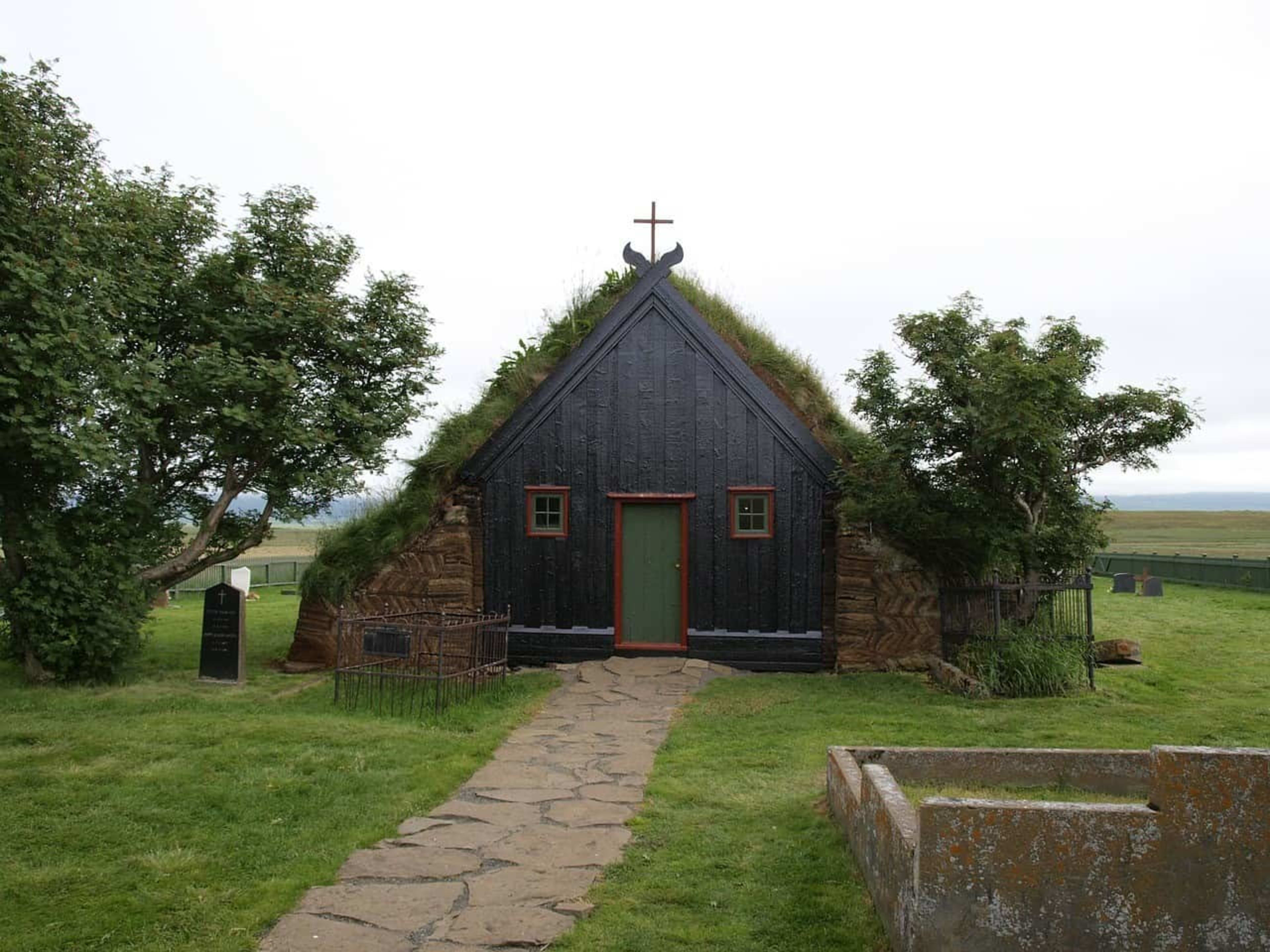Iceland’s grass-roofed houses are undoubtedly a part of the country’s persona and heritage. Through the rough climate and isolation, the turf houses kept the Vikings warm and throughout 11 hundred years until the houses you might see today were built.
Iceland might not have many ancient and grand buildings to show off like most of European countries, but if you look closely you’ll still find some of the old turf houses and can even visit them and explore.
In this blog, you will find everything you need to know about Iceland’s turf house history and modernization.
- See Icelandic turf houses on a self-drive tour of Iceland.
The history of turf houses in Iceland
If you visit Iceland today, it is quite hard to believe that once the country was largely covered in trees. In fact, research has shown that over 30% of Iceland was forested during its settlement years. In particular, birch was dominant just as it is today. So, even though our neighboring Scandinavian countries used oak to build their homes, Icelanders would use their darling birch.

However, with limited resources and people thinking too short ahead the trees were quickly used up. Sadly, this would take centuries to heal and cause land erosion all over the island. However, people still had to build a safe haven for them and their families. Digging deep into tradition to try to find a way to do so.
At this time turf roofs were already known in Norway, where most of the settlers were coming from. It was, therefore, something they recognized and appreciated. Furthermore Iceland was packed with suitable turf and therefore an excellent opportunity to build turf houses.

Not only did the turf offer premium insulation exceeding wood or stone, but it was also much easier to come by. This resulted in almost every single farm in Iceland being made up of turf houses.
At night people would gather in the largest room, the only one heated up with fire and tell each other stories, knit and make wool and skin products. Others would sing or recite poems and everyone would keep warm in this same room that everything took place in. This was called baðstofa, or basically the ‘bath living room’.
How were turf houses built?
Turf houses or torfbæir as they are called in Icelandic were largely made up from flat stones, wood, turf, and soil. A wooden frame would firstly be built, limiting the need for wood greatly. Secondly was the turf that would be laid down, often in a herringbone style and in two layers to seal the insulation.
The only additional wood to be added would be for doors and doorways. But those would also serve as decorative features and often be carved beautifully in the richer households. Furthermore, richer would households cover their floor in rocks or wood.

The biggest focus was on the baðstofa or the great hall were the whole family and entourage would gather for the night to eat, sleep, and socialize. Those would often house a special chimney so that the smoke from the turf house’s only fire could escape.
Do Icelanders still live in turf houses?
The quickest way to answer this question would be no. Icelanders don’t live in turf houses anymore. You might still see an occasional grass roof, but that has everything to do with architecture and Icelanders wanting to hold on to their beloved heritage rather than any need for turf as insulation material.
In the year 1890, over 87% of the population lived on turf farms in the countryside. However, from that time people started to move into larger settlements, from the countryside to the city and the colorful corrugated iron and wooden houses you see today in Reykjavík started coming to life.
By the end of the 19th century, a reign of 11 hundred years of turf houses in Iceland had come to an end.

Even so, you can still find preserved turf houses around Iceland. Many of which have been turned into museums or exhibitions giving you an amazing insight into the life in Iceland from the 9th century to the 18th. So, we take great pleasure in presenting to you the next chapter in this blog:
7 amazing turf houses you can visit today
1. Árbær in Reykjavík
For many kids raised in Reykjavík, this is their closest turf farm. It is a small cluster of houses, extremely well kept and the artifacts inside tell a dazzling story of life once lives. The staff often dress up in traditional clothing and you are surprisingly free to roam around and really explore. Not to mention how easily accessible it is with public bus from downtown Reykjavík.
It is the perfect place for families or simply someone curious about the old times. The museum is open to visitors all year round (with the exception of 25 December and 1 January).
2. Keldur in South Iceland
Here you will find the original. Keldur is the oldest turf house in Iceland and is beautifully well kept. It is where one of the characters in the famous Brennu-Njáls saga lived (Ingjaldur Höskuldsson) which only adds to its historic value. Later on, the family of Oddi including Jón Loftsson who raised the infamous Snorri Sturluson came to recite at Keldur.
The extraordinary turf houses at Keldur farm have been built many times over and ruins of about 18 farmsteads have been discovered throughout the years. The farm is located close to the roaring volcano Hekla and rocks from its eruptions have even been used to built the houses.
One of the more exciting things to explore at Keldur is the oldest remaining structure in Iceland. It is an old underpass believed to have been built as an escape route during the violent Sturlung Age!
The place is open for visitors in summer and surely a great spot to check out!
3. Skógar turf house at Skógafoss
Skógar is a splendidly put together farm cluster on the south coast, but is also so conveniently located near one of the must-sees: Skógafoss waterfall. It is, therefore, the perfect way to kill two birds with one stone. See the glorious waterfall and visit the beautifully reconstructed turf houses.

The unique feature about Skógar is that they are actually several turf houses from other areas that have been moved. They were then reconstructed and fixed in their own distinctive way giving visitors a magnificent insight into the different architecture that these buildings could actually possess.
You can go inside the houses where beds and homey things have been laid out. Thus giving an even better view of the life that once took place inside these walls.
There is plenty to see at Skógar, which has been a museum since 1949. A great additional stop to make along the south coast!
4. Stöng or Þjóðveldisbærinn
Many Game of Thrones fans might recognize this place as the scene where the Wildlings kill a whole village, leaving no one but a little boy.
Still, this is a fantastic rebuild of a farm from the settlement times that is believed to have been abandoned due to the volcano’s Hekla eruption in 1104. 22 farms are believed to have been evacuated during this eruption, leaving the fjord quiet.

5. Glaumbær in Skagafjörður, North Iceland
Located in the stunning fjord of Skagafjörður is Glaumbær turf farm and two 19th century wooden houses. It has been on display since 1952 and is to many the most glamorous of all of the turf homes in Iceland. Within its turf walls, you can find the most amazing clues into the life in the north in the old age displayed in an almost unbelievably real matter.

I remember roaming around in the museum as a kid and just feeling amazed by the way of life that my ancestors lived. Another highlight for me was also an Icelandic waffle with cream and jam at the end of each visit. As an adult, I still recommend it!
6. Laufás in Eyjafjörður, North Iceland
The farm at Laufás is a great example of a rich priest residency in the late 19th century in Iceland. The building is put together of five buildings, all connected through their turf bricks. Right next to the settlement is the pride and joy, the church.
The farm has a long history tracing back to the middle ages and some of the artifacts at the museum will have a similar story to tell. Some are from Laufas but others come from the neighboring farms. Laufás farm is one of the more remarkable turf farms in Iceland. The farm has not been rebuilt but simply just fixed up. This might have to due with the wealth that its former owners had. That gave them an opportunity to build from better material and maintain at a higher level.
7. Litlibær in Skötufjörður, Westfjords
If there ever was an award for the cutest little turf house, Litlibær would win. Litlibær farm was built in 1895 by two families that then lived in separate ends of the building. One of these family members was my great grandfather, so I hold a special bond with this place.
When you see the size of this farm, you can’t help but wonder how on earth people could fit two families in there but that still remains the fact. Outside were two outdoor kitchens and the farmers would fish in the nearby fjord. Litlibær remained a home until 1969.
Today you can visit to get to know life in the rural Westfjords at this time and it is a great stop for some coffee and cake.

About the author
Ragnheiður is a nature lover first and foremost, having studied anthropology and media at university. She also loves sharing her passion about her home country, Iceland, with everyone she meets. You’ll often find her traveling the Icelandic countryside, especially the Westfjords and south coast, although her hometown is Reykjavík. Her interests include Icelandic food and drink, plants and wildlife, and cultural traditions.
View more posts by Ragnheiður Harpa